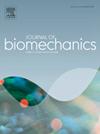Skin and cluster markers underestimate knee flexion during controlled motions. Evaluation of 12 patients with knee arthroplasty using radiosterometric analysis as reference
IF 2.4
3区 医学
Q3 BIOPHYSICS
引用次数: 0
Abstract
Diverse marker sets and validation techniques have previously been utilized, posing challenges in comparing studies when assessing soft tissue artefacts in knee joint kinematics from motion analysis. This study aimed to analyse the data obtained from three different marker sets with the results derived from radiostereometric analysis (RSA) in measuring angular movements of the knee joint. Twelve post-knee replacement participants performed a one-leg step-down movement. Knee joint angular movements were analysed in flexion–extension, adduction-abduction, and internal-external rotation across all marker sets. The results were subsequently compared with those obtained from the RSA system using simple linear regression, a linear mixed-effects model, mean values and mean differences. All marker sets were found to systematically underestimate flexion–extension compared to RSA, with differences intensifying at higher knee flexion angles. The mean differences in the sagittal plane between RSA and the IOR marker set, progressively increased from approximately 5° (95% CI 4.3–4.9) to 15° (95% CI 11.6–17.9), reaching a maximum difference of 20° (95% CI 13.8–25.7) at 40° of knee flexion. Transverse and frontal plane data from all marker sets exhibited erratic errors compared to RSA. In summary, knee flexion–extension motions were consistent between marker sets, indicating minimal impact on results based on the marker set choice. However, all marker sets systematically underestimated skeletal motions in knee flexion–extension compared to RSA measurements. Data from the transverse and frontal planes were too inconsistent and therefore not reliable for use.
求助全文
约1分钟内获得全文
求助全文
来源期刊

Journal of biomechanics
生物-工程:生物医学
CiteScore
5.10
自引率
4.20%
发文量
345
审稿时长
1 months
期刊介绍:
The Journal of Biomechanics publishes reports of original and substantial findings using the principles of mechanics to explore biological problems. Analytical, as well as experimental papers may be submitted, and the journal accepts original articles, surveys and perspective articles (usually by Editorial invitation only), book reviews and letters to the Editor. The criteria for acceptance of manuscripts include excellence, novelty, significance, clarity, conciseness and interest to the readership.
Papers published in the journal may cover a wide range of topics in biomechanics, including, but not limited to:
-Fundamental Topics - Biomechanics of the musculoskeletal, cardiovascular, and respiratory systems, mechanics of hard and soft tissues, biofluid mechanics, mechanics of prostheses and implant-tissue interfaces, mechanics of cells.
-Cardiovascular and Respiratory Biomechanics - Mechanics of blood-flow, air-flow, mechanics of the soft tissues, flow-tissue or flow-prosthesis interactions.
-Cell Biomechanics - Biomechanic analyses of cells, membranes and sub-cellular structures; the relationship of the mechanical environment to cell and tissue response.
-Dental Biomechanics - Design and analysis of dental tissues and prostheses, mechanics of chewing.
-Functional Tissue Engineering - The role of biomechanical factors in engineered tissue replacements and regenerative medicine.
-Injury Biomechanics - Mechanics of impact and trauma, dynamics of man-machine interaction.
-Molecular Biomechanics - Mechanical analyses of biomolecules.
-Orthopedic Biomechanics - Mechanics of fracture and fracture fixation, mechanics of implants and implant fixation, mechanics of bones and joints, wear of natural and artificial joints.
-Rehabilitation Biomechanics - Analyses of gait, mechanics of prosthetics and orthotics.
-Sports Biomechanics - Mechanical analyses of sports performance.
 求助内容:
求助内容: 应助结果提醒方式:
应助结果提醒方式:


